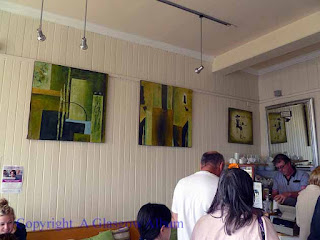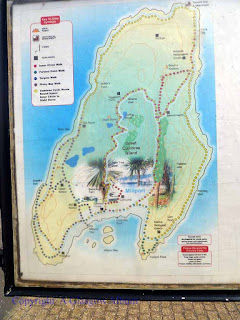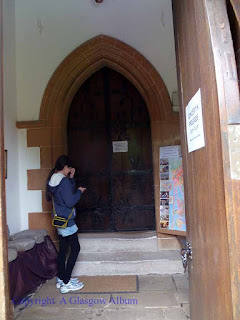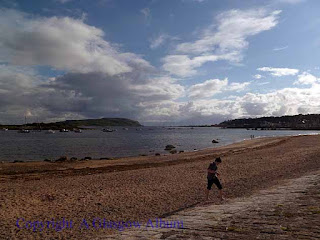- John Aubrey
Welcome to my wee photoblog on Glasgow, where we feature the joys and unjoys of walking and cycling through a fascinating, beautiful and often badly run city. For the blog's origin and a list of all posts see the 'Introduction' post -
http://glasgowalbum.blogspot.com/2010/02/introduction.html
Feel free to drop me an email with suggestions, offers of £20 notes etc. The address is damnyouebay@gmail.com. I have had to start watermarking the pics as I have come across one big website using a pic without permission - I suppose there must be others.
If you are a private individual and want to use any of the pics for non-commercial purposes please get in touch and I will usually be happy to say 'Aye' for free - just give the Album a credit. If you want to use a pic for commercial purposes a small mutually agreed fee and a credit will suffice.
Today is Sunday, 29 July, and we are off on a day trip to Millport on the Isle of Cumbrae to hear the great pianist Grace Mo play Chopin and a couple of pieces by the Scottish composer Henry James Creechan. The recital takes place in Cumbrae's Cathedral of the Isles, Europe's smallest cathedral -
http://www.largsandmillportnews.com/whatson/goingout/articles/2012/07/23/432483-a-chopin-afternoon-to-cherish/
From the above link -
'The Chopin Circle in Scotland is hosting international concert pianist, Grace Mo, as part of the renowned Music for a Summer Afternoon recitals in the Cathedral of the Isles, Isle of Cumbrae, Sunday 29th July at 3pm. Grace's Chopin Recital will be a chance to hear the exceptional musicality of this international prize-winning performer, who is travelling up from London especially to perform - pieces such as Chopin's Ballade No.1, Scherzos Nos. 3 and 4 and Chopin's much loved Barcarolle op.60. Thrillingly, she will compliment her recital with the world premiere of the Fantasy in Db Major and Sentiments Intimes by contemporary Classical Scottish composer, Henry James Creechan.'
 |
| In Largs, leaving the railway station |
 |
| Heading for the ferry |
 |
| The Cumbrae ferry on our right; the twin funnels of the Waverley in the background - the Waverley is the last ocean going paddle steamer in the world. For pics of her in Loch Lomond see http://glasgowalbum.blogspot.com/2010/02/balloch.html |
 |
| All shoes £10 - someone tell the Vikings |
 |
| On board and heading off - ferry leaves every 15 mins |
 |
| Out into the Firth of Clyde |
 |
| Our companion CalMac ferry. The service is likely to be privatised by the Scottish govt |
 |
| All seems peaceful but beneath us is a wilderness. The Firth of Clyde has been described as the UK's first marine desert, thanks to recent massive overfishing. There is a reserve on Arran where sea life is flourishing, but it is literally a drop in the ocean. http://www.bbc.co.uk/news/uk-scotland-glasgow-west-13165228 Says the respected fish2fork http://www.fish2fork.com/news-index/fears-of-marine-desert-in-firth-of-clyde-as-scientists-warn-of-langoustine-stock-collapse.aspx BRITAIN could soon have its first "marine desert". Researchers have warned that the sea in the Firth of Clyde has been so heavily fished that it risks being emptied of almost all life. The Clyde was once known for its halibut, cod, sharks and heavy catches of herring. However, these have almost all gone and the stock of langoustines, the shellfish which is now the area's only sizeable catch, could collapse through overfishing.' |
 |
| Approaching Cumbrae |
 |
| A comforting sign |
 |
| Cumbrae is popular with cyclists |
 |
| On the bus to the metropolis of Millport - passing cricketers |
 |
| In Millport now |
 |
| So this is where the Scooby gang retired to |
 |
| The main drag |
 |
| Rust never sleeps |
 |
| The fine Isle of Cumbrae Pipe Band. See http://www.iocpb.org/ |
 |
| The memorial to the war dead. Always shocking to see the lists of men who never came home to their wee villages |
 |
| Fran Healey of Travis began his songwriting career in Millport - http://en.wikipedia.org/wiki/Francis_Healy Travis' first single, "All I Want to Do Is Rock", was written by Healy while on a visit to Millport on Great Cumbrae, a small island in the Firth of Clyde. Going there with the sole intention of composing the best song he had ever written, Healy surprised even himself when the track was born.' Some also believe 'Why does it always rain on me' was written here - http://www.nothingtoseehere.net/2007/09/millport_isle_of_cumbrae.html |
 |
| We'll head up to the cathedral at about quarter to three |
 |
| We head up that road there. A boy clad normally except for an added pink tutu has just cycled past us heading into town - funded by the Scottish Surrealist Board no doubt |
 |
| Quick look at Crocodile Rock afore we go From the wiki entry on Cumbrae - http://en.wikipedia.org/wiki/Great_Cumbrae 'The island is on the Great Cumbrae fault line that runs north east to south west. Fault lines have formed some interesting rock formations which have become popular with tourists, including Crocodile Rock, Indian's Face, Lion's Rock and Queen Victoria's Face. Several have been enhanced with colourful paint.' There have recently been some suggestions that the rock is actually racist and is a depiction of a racist idea ('blackface') of a black man. The theory has little popular support |
 |
| Inside the Dancing Midge cafe |
 |
| Inside the Dancing Midge cafe |
 |
| We are now heading up to the cathedral - fine gateway on left |
 |
| Catholic church on right |
 |
| Another fine bit of rust |
 |
| Cathedral up here |
 |
| Ancient crosses |
 |
| The wonderful Grace Mo giving a bow This is Grace playing Chopin - http://www.youtube.com/watch?v=Ewnx9ynYdQg |
 |
| The composer Henry James Creechan on left |
 |
| Great wee brass lion - like a Scottie dog |
 |
| And a fine brass eagle |
 |
| Another look at the old crosses |
 |
| One of the loveliest church notices I have seen |
 |
| Back at that fine old building - the Cumbrae Medical Practice |
 |
| Back at the seafront |
 |
| Local art |
 |
| Flat for sale |
 |
| 'Cafe featured on Channel 4' |
 |
| A dead dogfish. They sell these as 'rock salmon' in chippies. Freshly caught of course, not beachcombed |
 |
| A fine seadog |
 |
| The guy on the left is that fine artist and teacher Jim Hardie. He owns one of the last flying Messerschmidts of WWII. See http://www.castleduncan.com/forum/index.php?/topic/1393-messerschmitt-restoration-project/ |
 |
| A sea horse |
 |
| Note windfarm in distance |
 |
| A wee flatfish in here |
 |
| See it? |
 |
| Waiting for bus back to ferry |
 |
| At ferry bus stop |
 |
| We meet Grace and Henry on the ferry - what a great day |
 |
| Crossing the marine desert |
 |
| Approaching Largs |
 |
| Please do not feed the gulls |
 |
| The great Nardini's - for many the finest ice cream cafe in Britain |
 |
| The age of art deco |
 |
| Kiosk catching the setting sun |
 |
| Railway station in view |
 |
| Glasgow train approacing |
 |
| The last of the light on the houses and hills |
 |
| Marina masts |
 |
| Photograph by Rowan |
http://parkeddogs.blogspot.com/
http://buddhasblackdog.blogspot.com/
Reviews of Scotland: 1000 Things You Need to Know
RADIO AND TELEVISON
'I love it - I'm giving this copy to a friend and buying another for myself' - Darren Adam, Presenter, Radio Forth, 17 November 2008
‘It’s a great wee book’ – Stephen Jardine, introducing Edwin Moore on Scottish Television’s Five-Thirty Show
'A fantastic book' - Scott Wilson , talk 107 Breakfast Show host
'A great read' - Dougie Jackson, Drivetime host, Smooth Radio 105.2
THE PRESS
'Despite its apparently humorous format, this is a serious and extensive dictionary on all things Scottish; from Jean Redpath to Lorne sausage, from Flodden to the Corries. Is particularly good on history and minutiae. There's a useful chapter on famous Scottish legal cases and another on literature. Excellent' - Royal Scottish Legion, Feb 2009
'This is the ultimate Scottish reference book' - Waterstones Christmas catalogue, 2008
'This is a fascinating look at the history of Scotland: its languages, politics and great achievements, from its origins in the ancient landmass of Laurentia 400 million years ago, to devolution and Billy Connolly. Edwin Moore has collected a thousand important facts about this beautiful country, covering Scottish history and culture, correcting misconceptions, and examining the mysteries of haggis and bagpipes with insight, warmth and impressive attention to detail' - The Good Book Guide, November 2008
'This is a recipe for revealing how horribly ill informed you are about your country. Although, if you are skillful, you can nod sagely as you read some new fact and mutter 'Ah, yes!' as if recalling the information from your excellent schooling. Where else will you find a real recipe for making haggis from scratch side by side with a potted biography of David Hume; a section of the Declaration of Arbroath and the curiously touching fact that Lulu was only 15 when she had a hit with 'Shout'? The whole thing is of course, silly - but oh so addictive.' - Matthew Perren, i-on Glasgow, December 2008
'. . . well crafted and witty' - Bill Howatson, Aberdeen Press and Journal, 18 October 2008
‘While most of Edwin’s entries are entertaining and scholarly – he writes like a Scottish Bill Bryson – it is when he takes an interest in the backwaters of history, the details lost down the back of the sofa, that he is at his best’ – Jack McKeown, The Courier, 27 October 2008
'History, it is said, is written by the victors. Trivia, meanwhile, is written by the guys with the smeared spectacles and the breathable rainwear. The first discipline is linear and causal; to quote from Alan Bennett’s play The History Boys, history is “just one f****** thing after another”. Things look different, though, when viewed through the prism of trivia. The past is reduced to one big coleslaw of fascinating facts that in their randomness tell a more mixed-up tale entirely.
The first approach leads to big, frowning books by the likes of Tom Devine and Michael Fry. The latter results in small, cheerful books such as Scotland: 1,000 Things You Need to Know, Edwin Moore’s valiant attempt to navigate the more trivial contours of enlightenment and clearances, crown and parliament, dirt and deity.
Moore proceeds from a sincere and controversial first principle: Scotland is really a rather pleasant and interesting place. . .As a work of popular scholarship, though, it’s in a different league to the Scottish novelty titles that get stocked next to the bookstore tills as potential impulse purchases, those little handbooks of parliamo Caledonia and regional braggadocio, such as Weegies vs Edinbuggers.' - Allan Brown The Sunday Times, 21 September 2008
'In his book, Scotland: 1000 Things You Need to Know, Edwin celebrates all that sets us Scots as a race apart - our language, law, flora, food, and of course, our people. From our poets, architects and inventors, to our artists, entertainers and fighters. But he doesn't shy away from the more unpleasant aspects of our history. . .' - Robert Wight, Sunday Post, 14 September 2008
‘We think we know all about William Wallace, Robert the Bruce and the Union of the Crowms. However, according to Edwin Moore, author of , Scotland: 1000 Things You Need to Know, we’re still in the dark about many aspects of our history and culture. . . The Big Issue looks at 20 of the most astonishing examples of secret Scotland.’ – The Big Issue, 18-24 September 2008
'What's the connection between Homer Simpson and Larbert, and why are generations of lawyers grateful to a Paisley snail? Need to know more? Author Edwin Moore has gathered 1000 facts like these about Scotland in a quirky new book. Brian Swanson selects a few favourites. . .' - Scottish Daily Express, 13 September 2008
'The palm for Christmas-stocking books seems to have passed recently to popular science, with best selling titles every year such as Why Don’t Penguins’ Feet Freeze? This year there has been a gallant attempt at a historical fight back. Scotland: 1,000 Things You Need to Know(Atlantic Books, £12.99) asks (and answers) such post-turkey questions as ‘How many kings of Scotland died in their beds?’, ‘Who on earth decided that the Declaration of Arbroath was the cornerstone of modern democracy?’ or ‘Why is iron brew spelled Irn-Bru?’ Mark Mazower,History Today; The Best of History in 2008, December 2008
'A real treat for the serendipitous Scotophile' - Reginald Hill
FROM THE INTERWEB
www.Booksfromscotland.com (on the new paperback edition)
Book of the Month, May 2010
'Whether it's Scottish lochs or Enlightenment philosophers, the facts of the devolution referendums or the mysteries of Irn-Bru, myths will be debunked and truths revealed in this light-hearted but rigorous overview of Scottish history and culture.'
Also available for download on Amazon's e-book store is my 100 Brief Encounters (only £3.06!)
http://www.amazon.co.uk/100-Brief-Encounters-ebook/dp/B006CQ8G84/ref=sr_1_1?s=books&ie=UTF8&qid=1322393003&sr=1-1
Here are some reviews of the print edition (published by Chambers in 2007) -
Edwin Moore's quirky collection of a hundred encounters between (mostly) important historical figures is a gem of a book. Where else could you get concise enlightening accounts of Henry VIII wrestling with Francis I, Geronimo surrendering to General Miles, Ernest Hemingway presenting Fidle Castro with a fishing trophy or (as seen on the books cover) a baby faced Bill Clinton shaking hands with John F Kennedy. A marvelous 'little window on human history. ' - Dominic Kennerk, Waterstone's Product Planning and Promotions Co-ordinator (From the Waterstone's 'We Recommend' list for 2008)
Witty, light and packed with information -- The Sunday Herald
In 1936, in the wake of winning a clutch of gold medals at the Berlin Olympics, the great athlete Jesse Owens was snubbed by an imperious leader, on racial grounds. Popular belief would have it that the leader was Hitler, who is said to have stormed off, furious to see a black man beating European athletes. In fact the man in question was President Roosevelt, who worried that paying attention to Owens' triumphs might be a vote loser. Although Owens and the German Chancellor never talked, Owens claimed that Hitler greeted him with an enthusiastic wave. Such near-misses, shakings of hands and ships-in-the-night meetings are the subject of Brief Encounters – Meetings between mostly remarkable people, a likeable new book by Edwin Moore (Chambers £7.99). Flicking through the index, you will find some expected encounters (Dante stares at Beatrice, Corday stabs Marat, The Beatles strum along to a Charlie Rich record round at Elvis's house), and the book's intriguing and memorable cover shows a baby-faced Bill Clinton manfully gripping the hand of JFK. But Moore has navigated past some of the more obvious collisions, collusions and confrontations of history (there is no Dr Livingstone, I presume) and much of the book's pleasure derives from lesser known incidents.
Inevitably, some of the accounts of earlier meetings are somewhat sketchy but Moore offers some piquant speculation, laced with humour (the book is tagged Reference / Humour, rather than History and this feels right, but the book, though wry and opinionated, never stoops to wackiness). I was intrigued to discover that, though Attila the Hun did die on his wedding night, it was not in drunken and lecherous debauchery, as his enemies maintained, but supposedly because he was generally a simple and clean-living man who had a few too many which brought on a particularly bad nosebleed.
Moore's book is full of such tales – it would be wrong of me to steal the tastiest morsels of his research and pepper this article with them, but look out for a subsidiary reason for the Gunpowder Plot (too many dour and powerful Scots in Parliament); a great meeting of great beards, as Castro wins the Hemingway prize for sea-fishing; Dali bringing a skeptical Freud round to the art of the surrealists; Buffalo Bill's wife claiming an aged Queen Victoria had propositioned him; Oscar Wilde getting a kiss from Walt Whitman, while Walter Scott was more taken with Burns's charismatic eyes. This is an enjoyable and vigorous rattle through some fascinating and believable yarns. My only quibble is that it's a little on the short side – let's have Volume 2 please Chambers! - Roddy Lumsden, www.Books from Scotland.com
'


















































































































































































































































































































































































No comments:
Post a Comment